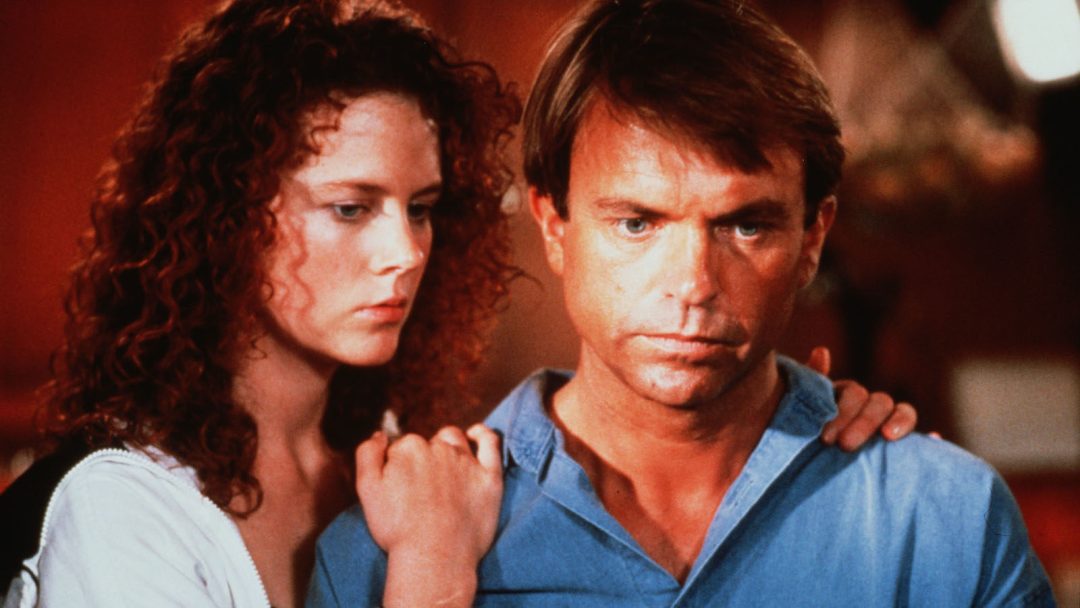Did you know a lost Orson Welles movie exists? It was called The Deep (not to be confused with the great Benchley, Shaw, Nolte, Bissett, Gosset Jr. film). Based on a novel by Charles Williams, The Deep was about a married couple sailing the high sea. They pick up the sole survivor of a sinking ship, and he turns out to be a psychopath.
Welles’ goal with The Deep was to make a commercially-viable film rather than an art-house movie. He worked on the film between 1966 and 1969. Financial and technical problems abounded, and Welles gave up. The original negative was lost, but two workprints still survive.
“Hey!” some nerd in the backrow speaks up. “The plot of Welles’ The Deep sounds like Dead Calm (1989), starring Sam Neill, Nichole Kidman and Billy Zane.”
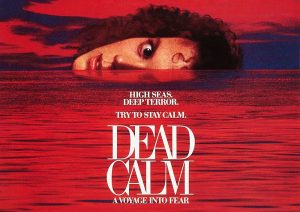
Yes, nerd, that is correct. That’s because the makers of Dead Calm read the book, liked it and bought the rights from Welles’ romantic partner, Oja Kodar. That’s why we are here today — to retro-review Dead Calm. Before we do, one more fascinating anecdote must be told. Charles Williams wrote the novel in 1963. It bears similarities to the 1961 Bluebelle Murders, which is an amazing story in and of itself.
The Bluebelle was a sailing ship out of Fort Lauderdale, Florida. It was scuttled after the captain committed mass murder. He killed his wife to collect insurance money. He also killed another man and woman sailing with them, along with two of their three children. Meanwhile, their eleven-year-old daughter was left behind to go down with the ship. The man was picked up by an oil tanker, told a made-up story about the Bluebelle catching fire, how everyone died but him and waited to collect his payday. Just one little problem — the girl he left behind didn’t go down with the ship. She huddled on a tiny float for four days before being rescued by a Greek freighter. Near death, she recovered and told the truth about what happened.
Trapped by his lies, the murderer committed suicide rather than face trial.
With such an interesting backstory, Dead Calm has a lot to live up to. For the most part, it does. Dead Calm is a decent little thriller. Let’s dive in.
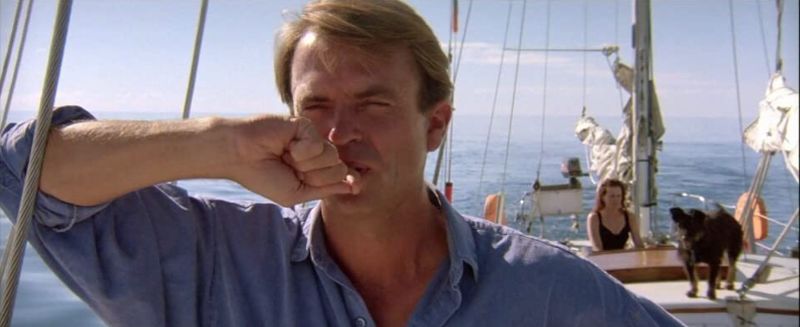
Captaining Dead Calm
Dead Calm is an Aussie production. Philip Noyce directed. Noyce has a quietly competent credits list, which includes big pictures like Patriot Games and Clear and Present Danger and trashy fun like Blind Fury, which is the last time Rutger Hauer seemed to care.
Terry Hayes did the screenplay. His first credit was Mad Max 2: The Road Warrior. It makes sense Hayes was brought on, as Mad Genius George Miller produced Dead Calm. Miller even directed some scenes, including a shark sequence that ended up being dropped from the final film. This makes sense, as Dead Calm has very little fat on it. No room for a shark scene exists.
Ultimately, Dead Calm is better as a movie than it is as a book. The movie simplifies things, boiling the story down to Sam Neill trying not to drown on a sinking boat while Nicole Kidman and Billy Zane play cat-and-mouse on the boat leaving him behind. This creates a nice A and B story that the movie switches back and forth between to keep up momentum.
The book also contains additional characters. The man played by Neill is not alone on the sinking boat. He is accompanied by two other people. This dilutes some of the suspense of the situation because he is not alone against the odds. In addition, the book spends a lot of time laying out the psychology behind Billy Zane’s character, and it got to the point where it pushed me to do massive amounts of skimming. The movie wisely jettisons all of that stuff and keeps things streamlined.
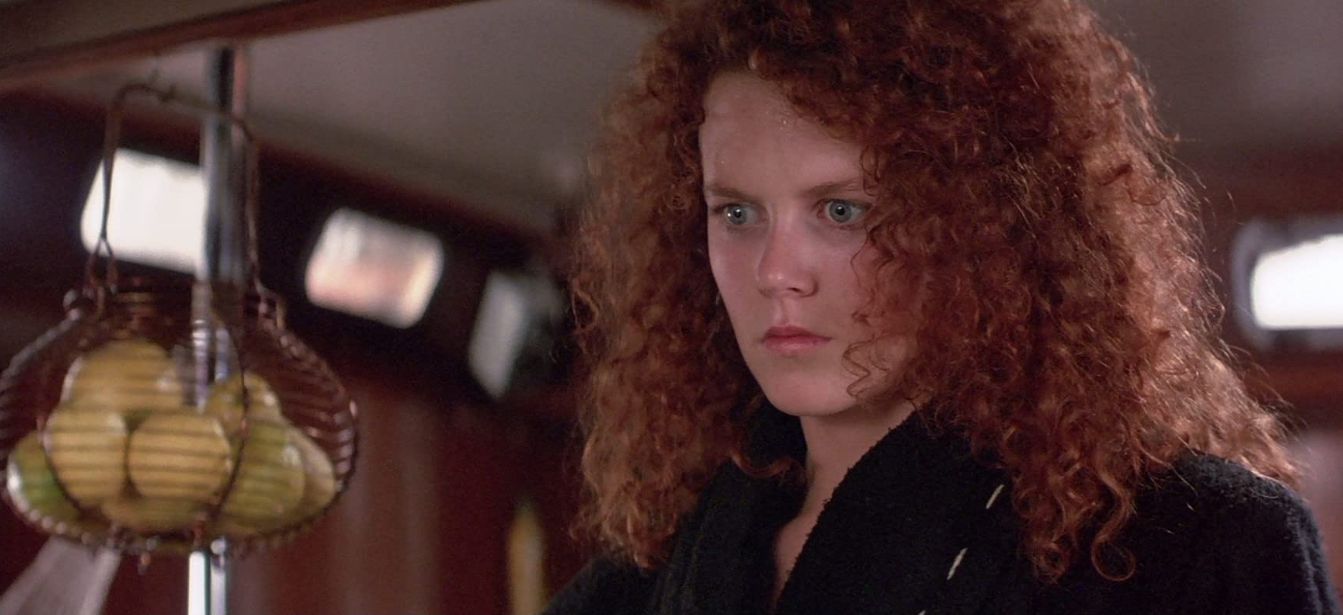
Crewing Dead Calm
Neill is a perplexing actor. To my eye, he has a weaselly undercurrent to him that lends itself more toward villain roles than hero roles. I always found his casting in Jurassic Park awkward because it is a total white-hat role that doesn’t fit him. Meanwhile, Neill is perfect in something like In The Mouth of Madness because his character is a flawed protagonist.
This is not really a problem in Dead Calm because the movie creates an interesting dynamic where all of the characters come off as having issues. A bit of backstory is given on the sailing couple at the beginning of the film, and it is gruesome enough to start the movie off a little bent. One cheers for Neill’s character, but it feels academic. He radiates a cold stiffness, and his marriage seems held together by a slide-ruler.
Which brings us to Neill’s wife in the film, Nicole Kidman. Dead Calm was one of Kidman’s first roles, and she was only about twenty years old at the time of filming. Meanwhile, Sam Neill was close to forty. This age difference gives their relationship an unspoken weirdness. Rather than be a detriment to the film, it works in a strange way. Dead Calm has a Grim fairy tale aspect to its tone. It is a riff on two characters tromping through the woods (ocean) and coming across an ogre.
Kidman has a challenging scene where she wrassles with the bad guy, and her clothes fall. It is uncomfortable because it pushes Kidman’s character into shades of gray, as well. Most movies wouldn’t have the heroine go to such a place, but Dead Calm forces a woman into a situation where she needs to be unfaithful to her husband in order to save her husband. It isn’t done in the spirit of exploitation. It’s simply the movie playing rough with the audience.
The final piece of the puzzle is Billy Zane in probably his sweatiest role. Like Neill, Zane is a weird actor. He has matinee idol looks but a quirkiness that undercuts them. Billy Zaney would be a better name for him. Yet, when it works, he is pretty magnetic. For example, I would have given Zane an Oscar nod for his turn as The Collector in Demon Knight.
Zane was a kid in Dead Calm, as well, but his twitchy mannerisms are full-grown. He is solid in the villain role. One can’t help but kind of like him, even as one knows he is crazy. Again, this adds to the skewed tone of Dead Calm. The movie should be a clear-cut case of two good people against one bad person, but it is more like watching a marble race on YouTube.
Look at the green one go! Oh wait, the yellow one is making a move! Now the blue one is coming out of nowhere, and here comes the finish line!
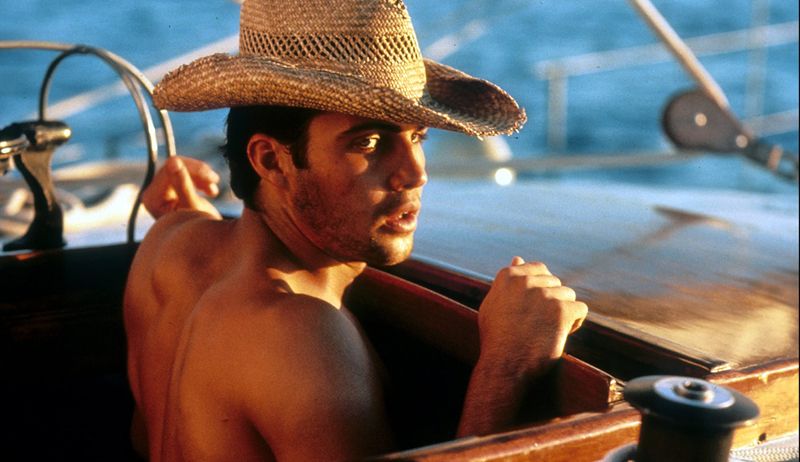
Docking Dead Calm
Dead Calm is an example of a movie that knows its lane. Everyone involved steers a steady course, yet the proceedings contain enough style to slightly float the movie above the standard line — not much, but a little. The work of cinematographer Dean Semler contributes to this. Semler worked on the Mad Max films and had already gone Hollywood before Dead Calm, lensing Cruise’s Cocktail and Young Guns. Semler later won the Academy Award for Dances with Wolves and reached the Schwarzenegger level with Last Action Hero.
I can’t put my finger on it, but Dead Calm has a slightly different look from other movies of the time. It is similar to Die Hard in this regard. When Die Hard came out, the way Jan de Bont shot it made it look different from every other action movie out there. A subtle element of that exists with Dead Calm, as well. It simply looks a bit richer than expected.
The music of Dead Calm creates ambiance, too. It made use of warbling female voices before warbling female voices became cliché, usually accompanying slow-motion death scenes. Graeme Revell scored the film. Revell appears to have the work ethic of Jerry Goldsmith. He consistently performed on multiple movies each year from 1990 to 2010. He seems to work exclusively within the genre market and formed one of industrial music’s first bands, SPK. At one of their concerts, they accidentally set an audience member on fire with a flamethrower. Not even Ozzy has done that.
All in all, Dead Calm is short and to the point. It flows naturally up to the outro, which is somewhat herky-jerky. Originally, Dead Calm ended on a more ambiguous note. The studio wanted the ending to be more clear-cut, and you can almost pinpoint the exact moment where the studio stepped in. This isn’t necessarily a bad thing, though. No need exists to overthink a movie like Dead Calm. A poppier ending was probably the way to go in the final analysis. One could say the decision was dead on for Dead Calm. Let’s go out on the smooth dancing moves of Billy Zane…


